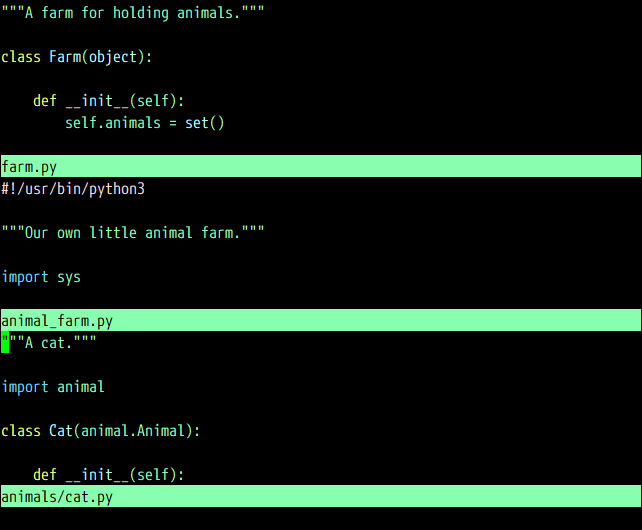Windows can also be moved, swapped, and resized. Since there's no drag-and-drop functionality in Vim, there are some commands you will have to remember.
As with the rest of the window commands, these are prefixed by Ctrl + w.
Ctrl + w followed, by an uppercase movement key (H, J, K, or L) will move the current window to the corresponding position:
- Ctrl + w, H moves the current window to the leftmost part of the screen
- Ctrl + w, J moves the current window to the bottom of the screen
- Ctrl + w, K moves the current window to the top of the screen
- Ctrl + w, L moves the current window to the rightmost part of the screen
For example, let's start with the following window layout (which was achieved by opening animal_farm.py and running :sp animals/cat.py, followed by :vs farm.py):

Note the cursor position (in animals/cat.py). Here's what happens when we try to move the window containing the animals/cat.py buffer in each direction:
-
Ctrl + w, H migrates animals/cat.py all the way to the left:

-
Ctrl + w, J moves animals/cat.py to the bottom of the screen, turning a vertical split into a horizontal split:

-
Ctrl + w, K moves animals/cat.py to the top of the screen:

- Ctrl + w, L moves animals/cat.py to the right of the screen:

You can change the contents of each window by simply navigating to it and selecting the desired buffer using the :b command. There are, however, options for swapping window contents:
- Ctrl + w, r moves every window within the row or the column (whichever is available—rows are given preference over columns) to the right or downward. Ctrl + w, R performs the same operation in reverse.
- Ctrl + w, x exchanges the contents of a window with the next one (or a previous one if it's considered a last window).
